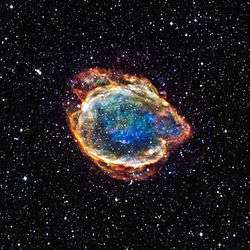SN 185
| Supernova SN 185 | |
|---|---|
| Observation data (Epoch J2000) | |
| Supernova type | Type Ia? |
| Remnant type | Shell |
| Host galaxy | Milky Way |
| Constellation | Circinus and Centaurus |
| Right ascension | 14h 43m |
| Declination | −62° 30′ |
| Galactic coordinates | G315.4−2.3 |
| Discovery date | December 7, 185 |
| Peak magnitude (V) | "as much as -8"[1] |
| Distance | 2,800 pc (9,100 ly)[2] |
| Physical characteristics | |
| Notable features | Ancient records of SN 185 may be the earliest written description of a supernova. |
| Other SNe | |
| Preceded by | None known |
| Succeeded by | SN 386 |
SN 185 refers to an AD 185 transient astronomical event that was likely a supernova. The transient occurred in the direction of Alpha Centauri, between the constellations Circinus and Centaurus, centered at RA 14h 43m Dec −62° 30′, in Circinus. This "guest star" was observed by Chinese astronomers in the Book of Later Han,[3] and might have been recorded in Roman literature.[1] It remained visible in the night sky for eight months. This is believed to be the first supernova for which records exist.
The following record was given by the Chinese of the supernova:
In the 2nd year of the epoch Zhongping [中平], the 10th moon, on the day Kwei Hae [December 7], a strange star appeared in the middle of Nan Mun [asterism containing Alpha Centauri], It was like a large bamboo mat. It displayed the five colors, both pleasing and otherwise. It gradually lessened. In the 6th moon of the succeeding year it disappeared.
The gaseous shell RCW 86 is probably the supernova remnant of this event and has a relatively large angular size of roughly 45 arc minutes[2] (larger than the apparent size of the full moon, which varies from 29 to 34 arc minutes). The distance to RCW 86 is estimated to be 2,800 parsecs (9,100 light-years).[2] Recent X-ray studies show a good match for the expected age.[4]
New infrared observations from NASA's Spitzer Space Telescope and Wide-field Infrared Survey Explorer (WISE) reveal how the supernova occurred and how its shattered remains ultimately spread out to great distances. The findings show that the stellar explosion took place in a hollowed-out cavity, allowing material expelled by the star to travel much faster and farther than it would have otherwise.[5]
Differing modern interpretations of the Chinese records of the guest star have led to quite different suggestions for the astronomical mechanism behind the event, from a core-collapse supernova[5] to a distant, slow-moving comet[6] – with correspondingly wide-ranging estimates of its apparent visual magnitude (−8 to +4). The recent Chandra results suggest that it was most likely a Type Ia supernova (a type with consistent absolute magnitude),[5][7] similar therefore to Tycho's Supernova (SN 1572), which had apparent magnitude −4 at a similar distance.

See also
- List of supernovae
- History of supernova observation
- List of supernova remnants
- List of supernova candidates
References
- 1 2 Stothers, Richard (1977). "Is the Supernova of A.D. 185 Recorded in Ancient Roman Literature?". Isis. 68 (3): 443–447. doi:10.1086/351822. JSTOR 231322.
- 1 2 3 Völk HJ; Berezhko EG; Ksenofontov LT (2005). "Magnetic field amplification in Tycho and other shell-type supernova remnants". Astron Astrophys. 433 (1): 229–40. arXiv:astro-ph/0409453
 . Bibcode:2005A&A...433..229V. doi:10.1051/0004-6361:20042015.
. Bibcode:2005A&A...433..229V. doi:10.1051/0004-6361:20042015. - ↑ Zhao FY; Strom RG; Jiang SY (2006). "The Guest Star of AD185 Must Have Been a Supernova". Chinese J Astron Astrophys. 6 (5): 635–40. Bibcode:2006ChJAA...6..635Z. doi:10.1088/1009-9271/6/5/17.
- ↑ "New evidence links stellar remains to oldest recorded supernova". ESA News. 2006-09-18. Retrieved 2006-05-24.
- 1 2 3 "NASA Telescopes Help Solve Ancient Supernova Mystery". NASA. 2011-10-24. Retrieved 2011-10-25.
- ↑ Y.-N. Chin; Y.-L. Huang (29 September 1994). "Identification of the Guest Star of AD 185 as a comet rather than a supernova" (PS). Nature. pp. 398–399. doi:10.1038/371398a0.
- ↑ Williams, Brian J.; et al. (October 2011). "RCW 86: A Type Ia Supernova in a Wind-blown Bubble". The Astrophysical Journal. 741 (2): 96. arXiv:1108.1207v1
 . Bibcode:2011ApJ...741...96W. doi:10.1088/0004-637X/741/2/96.
. Bibcode:2011ApJ...741...96W. doi:10.1088/0004-637X/741/2/96.
External links
- NASA Astronomy Picture of the Day: RCW 86: Historical Supernova Remnant (28 September 2006)
- NASA Astronomy Picture of the Day: RCW 86: Historical Supernova Remnant (10 November 2011)
- BBC News – Ancient supernova mystery solved (25 October 2011)

